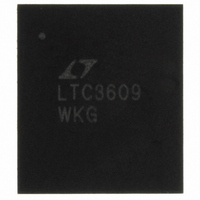LTC3609EWKG#PBF Linear Technology, LTC3609EWKG#PBF Datasheet - Page 17

LTC3609EWKG#PBF
Manufacturer Part Number
LTC3609EWKG#PBF
Description
IC DC/DC CONV STP-DWN 6A 52-QFN
Manufacturer
Linear Technology
Type
Step-Down (Buck)r
Datasheet
1.LTC3609EWKGPBF.pdf
(26 pages)
Specifications of LTC3609EWKG#PBF
Internal Switch(s)
Yes
Synchronous Rectifier
Yes
Number Of Outputs
2
Voltage - Output
0.6 ~ 36 V
Current - Output
6A
Voltage - Input
4 ~ 32 V
Operating Temperature
-40°C ~ 125°C
Mounting Type
Surface Mount
Package / Case
52-QFN
Lead Free Status / RoHS Status
Lead free / RoHS Compliant
Power - Output
-
Frequency - Switching
-
Available stocks
Company
Part Number
Manufacturer
Quantity
Price
applicaTions inForMaTion
Efficiency Considerations
The percent efficiency of a switching regulator is equal to
the output power divided by the input power times 100%.
It is often useful to analyze individual losses to determine
what is limiting the efficiency and which change would
produce the most improvement. Although all dissipative
elements in the circuit produce losses, four main sources
account for most of the losses in LTC3609 circuits:
1. DC I
internal resistance of the MOSFETs, inductor and PC
board traces and cause the efficiency to drop at high
output currents. In continuous mode the average output
current flows through L, but is chopped between the top
and bottom MOSFETs. The DC I
can simply be determined by [R
2. Transition loss. This loss arises from the brief amount
of time the top MOSFET spends in the saturated region
during switch node transitions. It depends upon the
input voltage, load current, driver strength and MOSFET
capacitance, among other factors. The loss is significant
at input voltages above 20V and can be estimated from:
Transition Loss ≅ (1.7A
3.3V OR 5V
Figure 5. RUN/SS Pin Interfacing with Latchoff Defeated
2
R losses. These arise from the resistance of the
D1
(5a)
V
IN
R
SS
*
RUN/SS
–1
C
SS
) V
IN
2
DS(ON)
2
R loss for one MOSFET
I
OUT
*OPTIONAL TO OVERRIDE
OVERCURRENT LATCHOFF
INTV
+ R
C
2N7002
CC
RSS
R
D2*
SS
(5b)
L
] • I
*
f
RUN/SS
O
.
3609 F05
C
SS
3. INTV
and control currents. This loss can be reduced by supply-
ing INTV
efficiency source, such as an output derived boost network
or alternate supply if available.
4. C
filtering the large RMS input current to the regulator. It
must have a very low ESR to minimize the AC I
sufficient capacitance to prevent the RMS current from
causing additional upstream losses in fuses or batteries.
Other losses, including C
conduction loss during dead time and inductor core loss
generally account for less than 2% additional loss.
When making adjustments to improve efficiency, the input
current is the best indicator of changes in efficiency. If you
make a change and the input current decreases, then the
efficiency has increased. If there is no change in input
current, then there is no change in efficiency.
Checking Transient Response
The regulator loop response can be checked by looking
at the load transient response. Switching regulators take
several cycles to respond to a step in load current. When
a load step occurs, V
equal to ∆I
resistance of C
charge C
regulator to return V
this recovery time, V
or ringing that would indicate a stability problem. The I
pin external components shown in Figure 6 will provide
adequate compensation for most applications. For a
detailed explanation of switching control loop theory see
Application Note 76.
IN
loss. The input capacitor has the difficult job of
CC
OUT
CC
current. This is the sum of the MOSFET driver
LOAD
current through the EXTV
generating a feedback error signal used by the
OUT
(ESR), where ESR is the effective series
. ∆I
OUT
OUT
OUT
LOAD
immediately shifts by an amount
OUT
to its steady-state value. During
can be monitored for overshoot
also begins to charge or dis-
ESR loss, Schottky diode D1
CC
LTC3609
pin from a high
2
R loss and
3609fb
TH













